Introduction
Understanding the intricate relationship between pelvic floor health and core muscle function is essential for fostering overall well-being. As the foundation of our physical stability, the pelvic floor is a complex network that supports vital organs and plays a pivotal role in daily activities.
With alarming statistics indicating that nearly one in four adults may experience pelvic floor disorders by 2030, it becomes increasingly important to prioritize education and proactive measures. By delving into effective exercises, breathing techniques, and the integration of core stability practices, individuals can empower themselves to enhance their pelvic health and embrace a more active, confident lifestyle.
This article explores the multifaceted approach needed to strengthen the pelvic floor, offering actionable insights that can transform health and well-being for individuals and teams alike.
Understanding Pelvic Anatomy and Core Muscle Function
The strength and function of central muscles are crucial for pelvic health, which can be improved by incorporating deep core exercises for pelvic floor. The lower abdominal region comprises a network of muscles and connective tissues that offer crucial support for reproductive organs, including the bladder, uterus in women, and rectum. By gaining a deeper understanding of lower body anatomy, we can better appreciate how central muscles—such as the transverse abdominis, multifidus, and diaphragm—collaborate to ensure stability and posture.
Fortifying these core muscles with deep core exercises for pelvic floor not only improves our physical stability but also greatly aids in decreasing lower body dysfunction, urinary incontinence, and related discomfort. As emphasized by the article 'Association Between Physical Activity and Disorders of the Pelvis in Parous Ugandan Women' published in the International Urogynecology Journal, the prevalence of such disorders is a pressing concern, impacting nearly one in four adults by 2030, as severe obesity rates rise to 24.2%. This highlights the necessity for effective exercise programs that include deep core exercises for pelvic floor to enhance health in that area.
Additionally, a case study titled 'Risk Factors Associated with Disorders of the Pelvis' revealed that age, race, and BMI were independently linked to these disorders, highlighting the significance of proactive measures. Expert findings from Wu et al. reinforce that age, higher BMI, greater parity, and hysterectomy are linked to elevated odds of one or more disorders of the lower body, emphasizing the necessity for targeted educational initiatives.
By prioritizing the education of our teams on anatomy and core muscle function, we can cultivate an environment that values well-being and empowers individuals to take charge of their health.
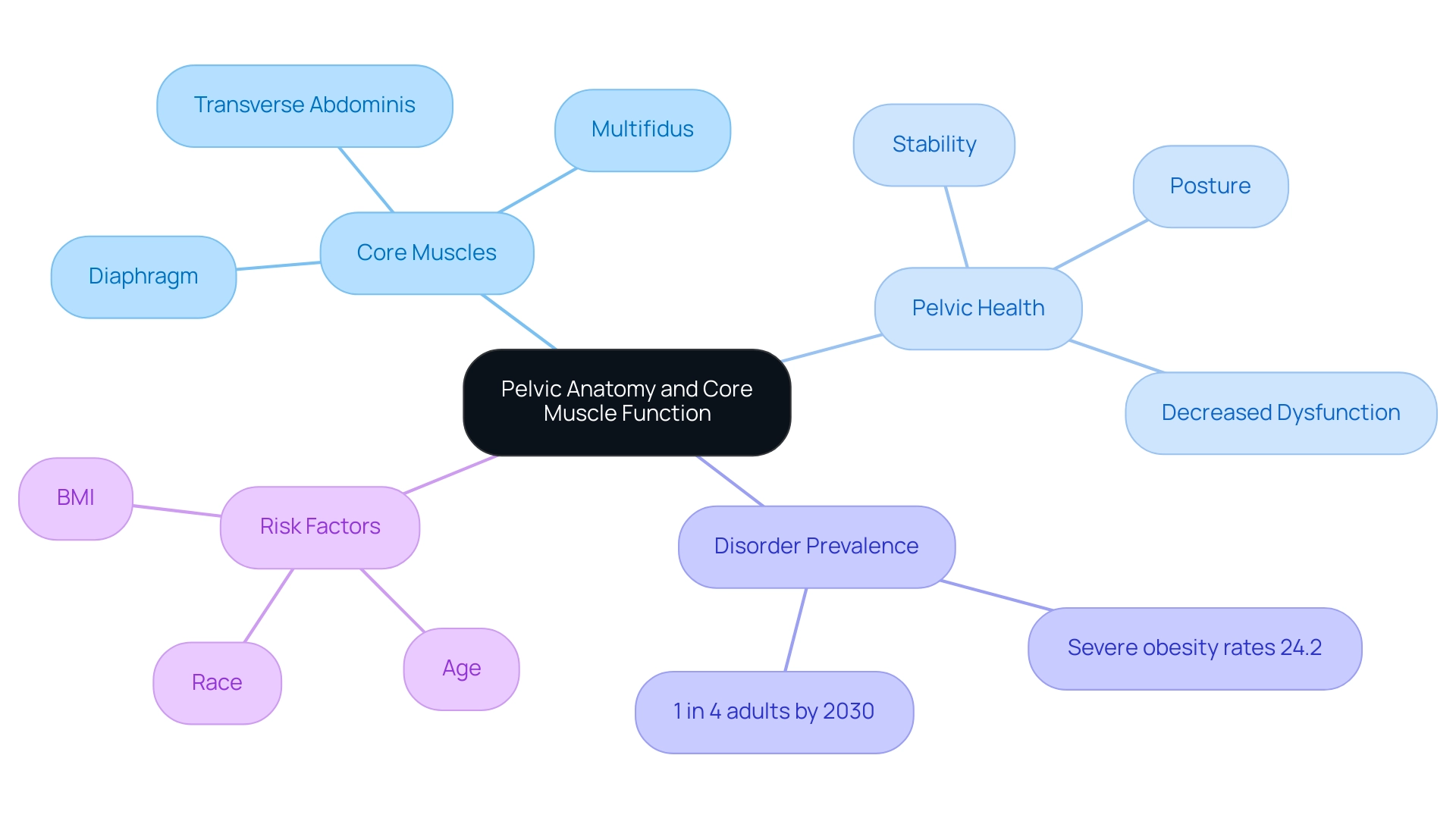
Effective Exercises for Strengthening the Pelvic Floor
- Kegel Exercises: Start by locating your support muscles in the lower region. Imagine you are trying to halt urination; contract these muscles and hold for five seconds before relaxing. Aim for 10 to 15 repetitions, three times daily, to build strength effectively. Studies show that following routines for the lower body can greatly affect overall health in that area. Notably, Cavkaytar et al. recommended a minimum of eight weeks for noticeable improvement, emphasizing the importance of consistency in practice. Furthermore, although the sample size of studies on Kegel exercises has been relatively small and based on convenience sampling, the positive outcomes reported emphasize the potential advantages of these exercises for health.
- Bridge Pose: Position yourself on your back, knees bent, and feet flat on the ground. Raise your hips toward the ceiling while simultaneously activating your core muscles. Hold this position for five seconds before releasing. Repeat this movement 10 to 15 times. This activity not only fortifies the lower abdomen but also improves overall stability, making it a potent addition to any fitness regimen. Integrating supervised training can further improve the effectiveness of this activity, especially for those dealing with lower body dysfunction.
- Dead Bug Exercise: Lie on your back with arms extended toward the ceiling and knees bent at a 90-degree angle. Lower one arm and the opposite leg toward the ground while keeping abdominal engagement. Alternate between sides for 10 to 12 repetitions. This activity effectively focuses on both the lower body region and core muscles, promoting overall strength and stability. Incorporating these routines into your daily schedule can lead to significant enhancements in health. Success narratives are plentiful, highlighting individuals who have enhanced their core stability through committed practice. Furthermore, case studies recommend individualized training programs and brief biofeedback sessions with a physiotherapist to enhance the effectiveness of Kegel routines, emphasizing the importance of deep core exercises for pelvic floor, persistence, and proper technique. For additional resources, consider bulk downloading StatPearls data and exploring links to PubMed Central citations for more insights into support health.
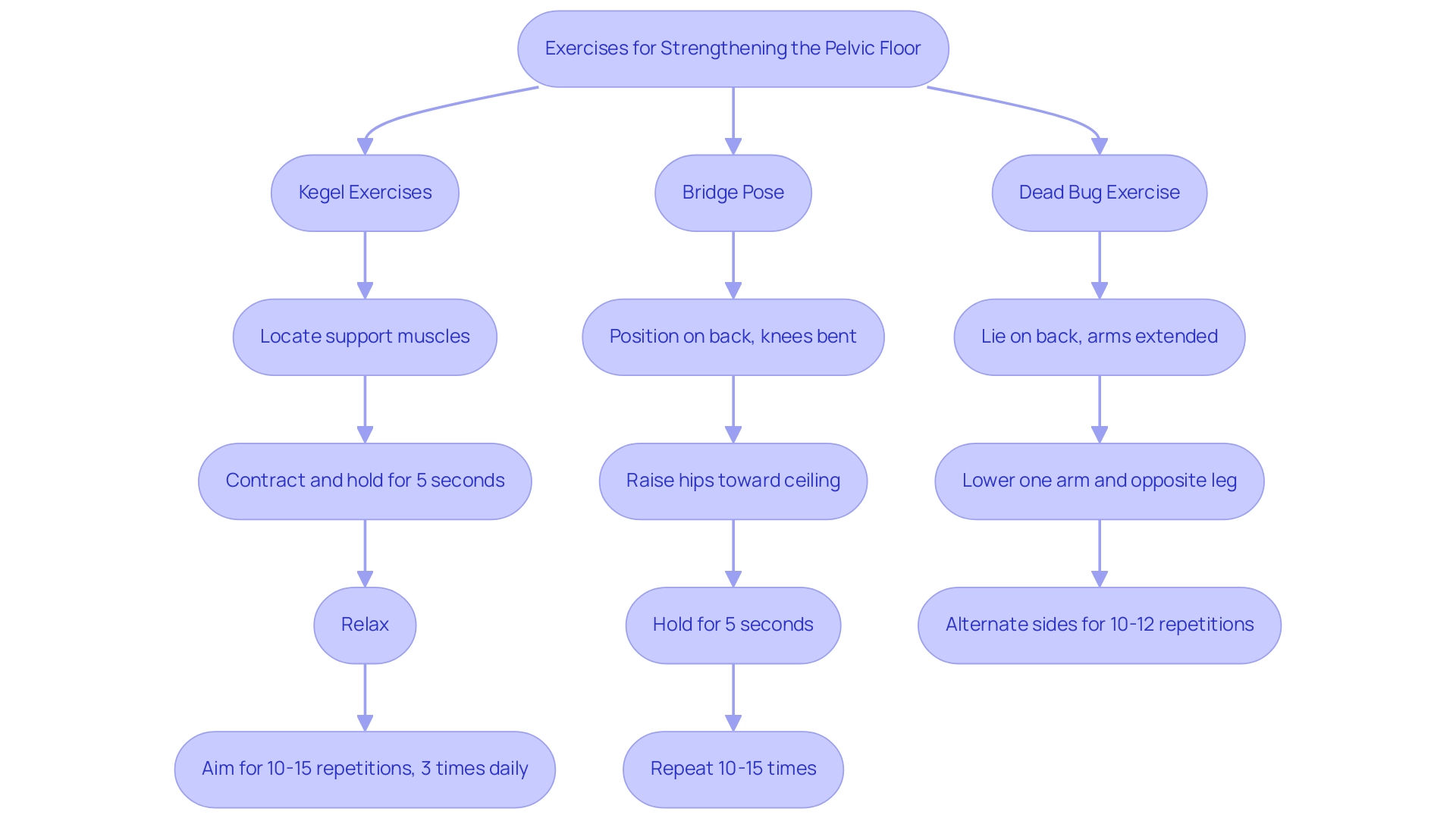
Incorporating Breathing Techniques and Alignment for Optimal Results
Incorporating deep core exercises for pelvic floor into your workout regimen can significantly improve stability in the torso and enhance pelvic floor involvement. Start with Diaphragmatic Breathing: inhale deeply through your nose, allowing your diaphragm to expand fully. As you exhale slowly through your mouth, engage your core muscles.
Practicing this for a few minutes before starting your routines sets a solid foundation for effective movement.
Next, focus on Alignment: it is crucial to maintain a neutral spine during activities. Keep a relaxed posture, ensuring your shoulders are down and away from your ears. Proper alignment not only facilitates optimal muscle engagement but also minimizes the risk of injury.
A randomized controlled trial in 2005 demonstrated a significant difference (p<0.05) in outcomes between trunk muscle stabilization training combined with general physical activity and general physical activity alone, highlighting the importance of these techniques. Furthermore, a case study titled "Comparison of Breathing and Core Stabilization Activities" found that the stabilization activity group showed greater improvements in thoracic mobility compared to the control group, underscoring the effectiveness of integrating these methods.
Integrating breathing techniques with correct alignment can greatly enhance the efficiency of deep core exercises for pelvic floor during your workouts. According to Nicole Nelson,
Conversely, diaphragmatic breathing is correlated with various positive health benefits including reduced resting heart rate, post-exercise oxidative stress, increased postural control, and baroreflex sensitivity.
This highlights the importance of diaphragmatic breathing in developing a stronger, more resilient center and lower body.
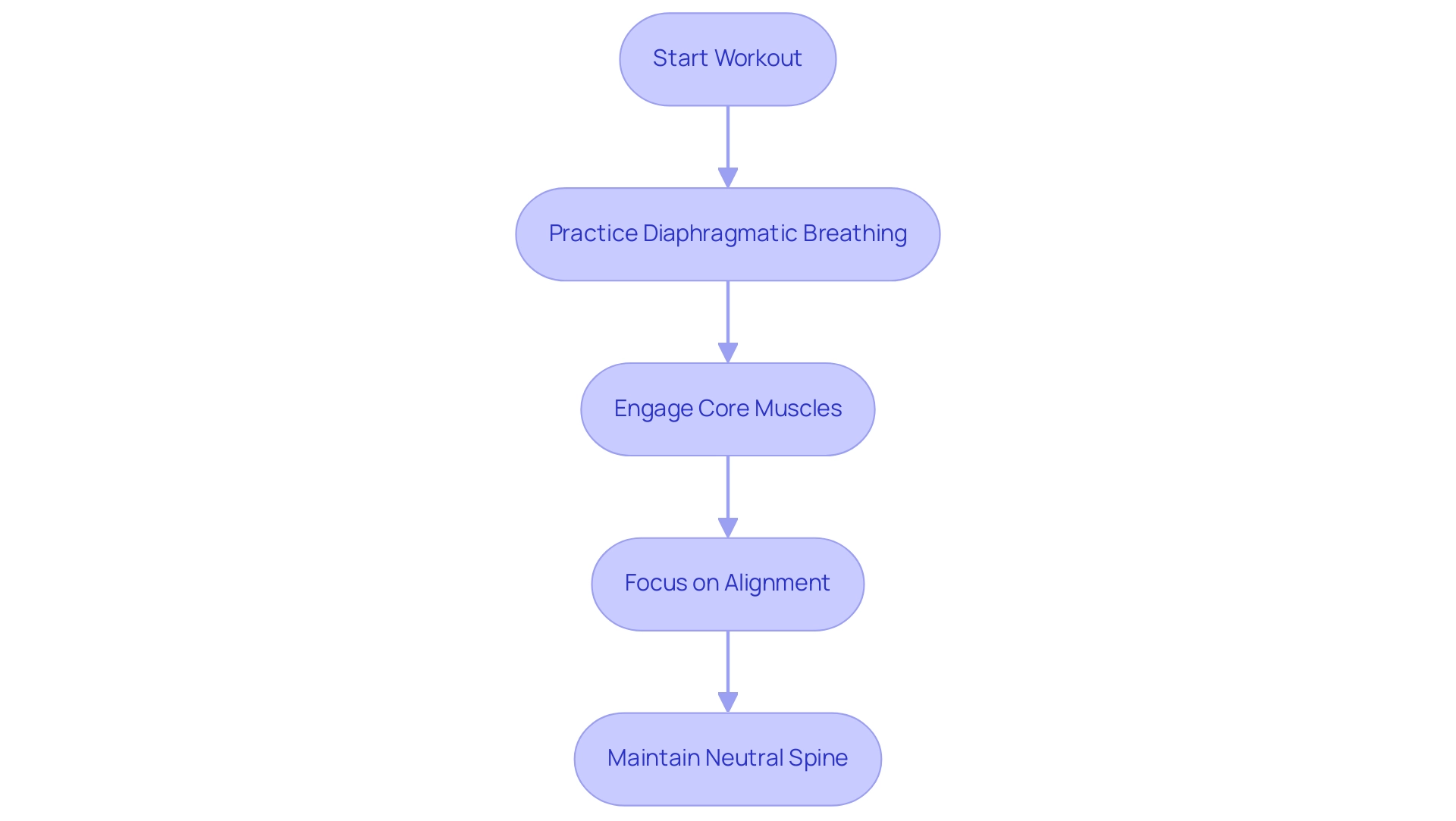
Benefits of Deep Core Exercises for Pelvic Floor Health
Engaging in deep core exercises offers transformative benefits for pelvic floor health that extend beyond mere physical fitness:
- Improved Stability: Strengthening these core muscles significantly enhances overall stability, thereby reducing the risk of falls and injuries, which is crucial in maintaining an active lifestyle.
- Reduced Pain: Regular practice of deep core routines has been shown to alleviate discomfort in the lower abdomen, leading to a more comfortable daily experience and improved quality of life, especially for individuals experiencing stress urinary incontinence (SUI). In a study involving 60 women, participants reported significant reductions in distress, highlighting the effectiveness of these exercises.
- Enhanced Performance: A strong core not only contributes to daily well-being but also supports improved athletic performance, allowing individuals to participate in physical activities with greater efficiency and effectiveness.
- Increased Confidence: Enhanced health of the lower body fosters greater confidence in physical activities and overall life satisfaction, empowering individuals to pursue their goals without the fear of discomfort or instability.
According to a meta-analysis, the ICIQ-UI SF enhanced by roughly three points from baseline for women undergoing supervised muscle training, further illustrating the positive effect of these activities. Furthermore, as pointed out by health specialists, "deep core exercises for pelvic floor are advantageous in preserving abdominal muscle coordination, support, endurance, and strength." By including deep core exercises for pelvic floor in your routine, you can experience these advantages firsthand, transforming not only your physical health but also enhancing your overall sense of well-being.
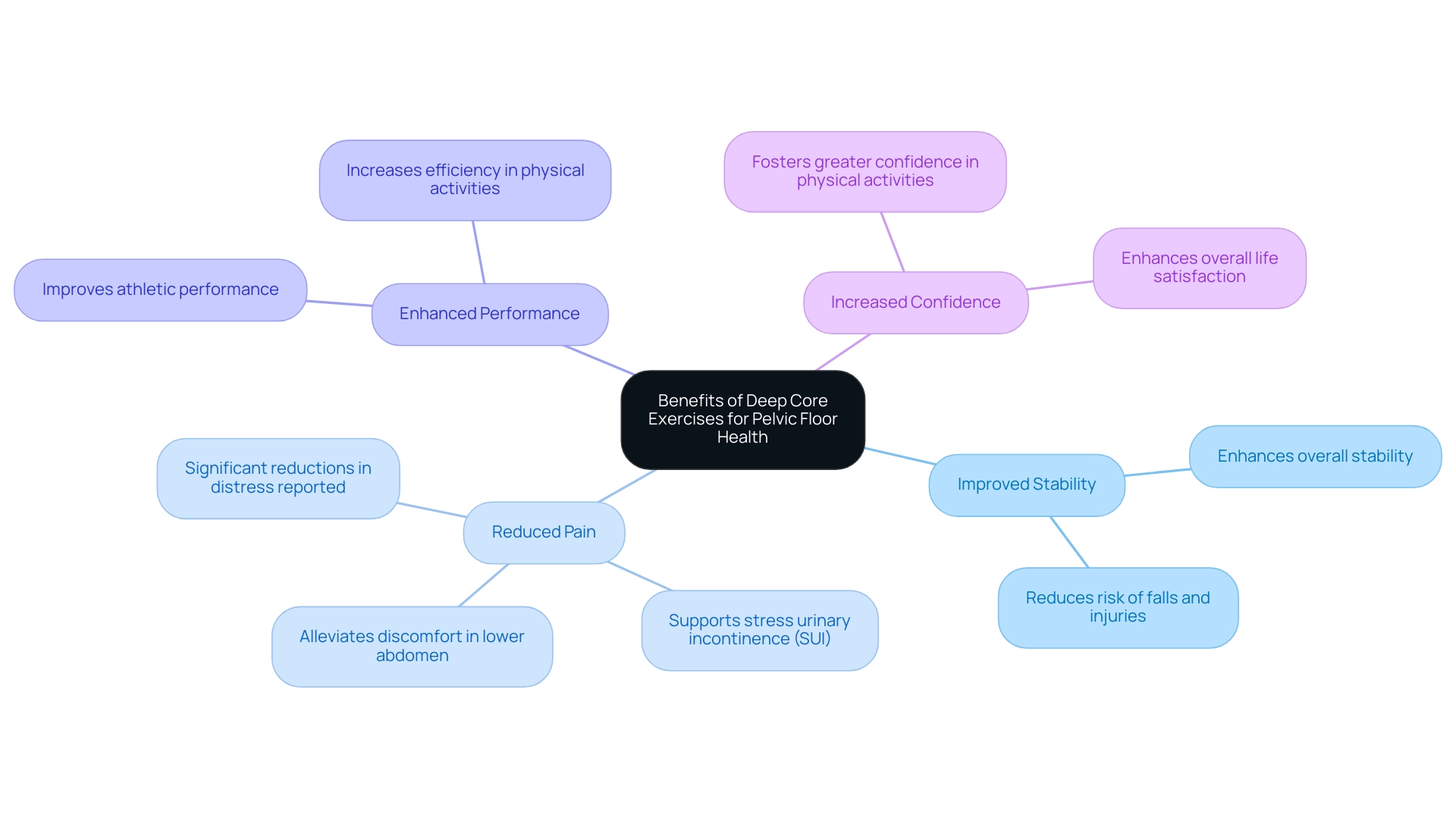
How to Safely Integrate Deep Core Exercises into Your Routine
To effectively and safely incorporate deep core activities into your routine, consider the following essential guidelines:
- Start Slowly: For those new to physical activity, it’s crucial to begin with foundational movements. Gradually increase the intensity as your body adapts. The emphasis on a progressive approach is vital; a sudden increase in intensity can lead to injury and discourage continued participation.
- Listen to Your Body: Your body is an excellent communicator. Pay close attention to how you feel during and after physical activities. If you encounter discomfort or pain, it’s important to stop and consult a healthcare professional. This reflective practice not only ensures safety but also fosters a positive relationship with exercise.
- Consistency is Key: Aim for regularity rather than focusing solely on intensity. Participating in intensive core workouts a few times weekly can result in significant enhancements in lower body health over time. Statistics indicate that regular physical activity is more effective for long-term health benefits than sporadic high-intensity workouts. This is particularly relevant in light of the global target of a 15% relative reduction in physical inactivity by 2030, highlighting the importance of establishing healthy habits.
- Seek Guidance: Don’t hesitate to consult a fitness expert or physical therapist who specializes in health related to the pelvic area. Their expertise can offer tailored guidance and assist you in creating a thorough strategy that matches your unique requirements.
By following these recommendations, you not only guarantee a secure introduction to deep core exercises for pelvic floor health but also reveal the potential for improvement. The Global Status Report on Physical Activity 2022 underscores the ongoing challenge of achieving recommended activity levels, with over 80% of adolescents failing to meet WHO guidelines. This highlights the significance of developing healthy fitness habits early, particularly as initiatives to increase daily school physical education participation among adolescents are currently facing setbacks.
As G D Myer from Cincinnati Children’s Hospital Medical Center states, the acceptance of supervised and well-designed youth resistance training is gaining universal recognition. This growing acknowledgment can serve as a motivating factor in prioritizing well-structured exercise programs for everyone, regardless of age.
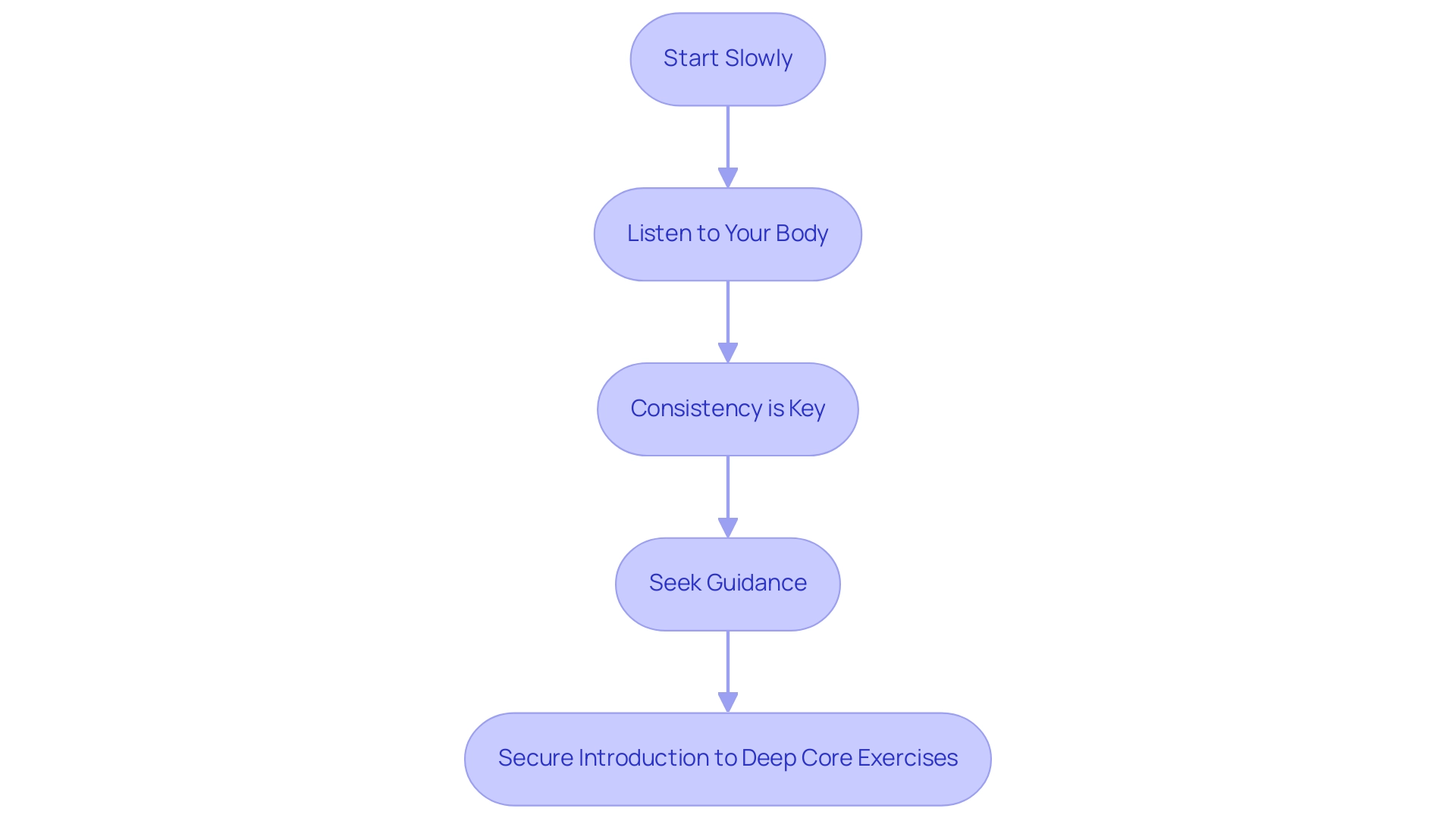
Conclusion
Strengthening pelvic floor health is a multifaceted endeavor that requires a comprehensive understanding of both anatomy and effective exercise techniques. As explored throughout the article, the connection between the pelvic floor and core muscles is critical for overall stability, reducing the risk of dysfunction, and enhancing daily living. By incorporating targeted exercises like Kegels, bridge poses, and dead bug movements, individuals can take proactive steps toward improving their pelvic health.
Moreover, integrating breathing techniques and maintaining proper alignment during workouts amplifies these benefits. The importance of deep core exercises cannot be overstated; they not only contribute to improved stability and reduced pain but also enhance athletic performance and boost confidence. By adhering to a consistent routine and listening to one's body, individuals can safely incorporate these exercises into their daily lives, leading to transformative changes in their overall well-being.
As the statistics indicate a rising prevalence of pelvic floor disorders, it becomes imperative to prioritize education and proactive measures within teams and communities. By fostering an environment that emphasizes the significance of pelvic health, organizations can empower individuals to take charge of their well-being, ultimately paving the way for a more active and confident lifestyle. Now is the time to act—invest in pelvic floor health and witness the profound impact it can have on quality of life.
Frequently Asked Questions
Why are central muscles important for pelvic health?
Central muscles are crucial for pelvic health as they provide support for reproductive organs, including the bladder, uterus, and rectum. Strengthening these muscles can improve stability and decrease lower body dysfunction.
What are deep core exercises for pelvic floor?
Deep core exercises for pelvic floor include routines like Kegel exercises, Bridge Pose, and Dead Bug Exercise, which aim to strengthen the lower abdominal region and improve pelvic health.
How do deep core exercises benefit individuals?
These exercises improve physical stability, reduce urinary incontinence, and alleviate related discomfort, contributing to overall pelvic health.
What is the prevalence of pelvic disorders?
According to a study published in the International Urogynecology Journal, nearly one in four adults is expected to be impacted by pelvic disorders by 2030, highlighting the need for effective exercise programs.
What factors are linked to pelvic disorders?
Age, race, and body mass index (BMI) are independently associated with pelvic disorders, indicating the importance of proactive health measures.
How can Kegel exercises be performed effectively?
To perform Kegel exercises, locate the support muscles in the lower region, contract them as if trying to halt urination, hold for five seconds, and relax. Aim for 10 to 15 repetitions, three times daily for best results.
What is the Bridge Pose and how is it performed?
The Bridge Pose involves lying on your back with knees bent and feet flat, raising your hips toward the ceiling while engaging your core. Hold for five seconds and repeat 10 to 15 times to strengthen the lower abdomen and improve stability.
How do you perform the Dead Bug Exercise?
Lie on your back with arms extended toward the ceiling and knees bent at a 90-degree angle. Lower one arm and the opposite leg toward the ground while keeping your core engaged, alternating sides for 10 to 12 repetitions.
What is the recommended duration for seeing improvements from Kegel exercises?
Studies suggest a minimum of eight weeks of consistent practice is needed to notice significant improvements from Kegel exercises.
Why is education on anatomy and core muscle function important?
Educating individuals on anatomy and core muscle function can foster an environment that promotes well-being and empowers people to take charge of their health, particularly regarding pelvic health.

